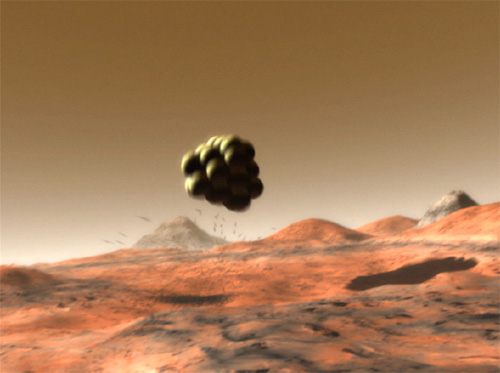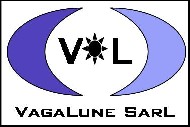| Overview |
| |
| Launch/Orbit |
| |
| Rover/Lander |
| |
| Communications |
| |
| Project Execution |
| |
| Project Management |
| |
| References |
|
| Landing Specifications |
| |
| Upon entry into a stable orbit (EL40) around the moon, the Lunar Module (LM) will begin preparations for descent to the lunar surface. Attitude adjustments will align the LM so that its reverse thrusters are facing the lunar surface. Still continuing in its orbit while performing these manoeuvers, the normal ion drive engines on the now top-side of the LM will put the LM into its descent pattern. At a specified time, the solar panels will detach from the body of the LM. The reverse thrusters will exhaust their fuel and then they will also detach from the LM allowing the airbags* to inflate. (See also Orbit Summary) |
| |
From JPL, Mars Exploration Rover in Airbags.
 |
| |
| With the craft in free-fall toward the lunar surface, it will attempt to land in the grid between 30°W and 20°W longitude and between 0° and 10°S latitude. (Inside this grid are Apollo 12 and Surveryor 3 modules from historical missions.) The airbags will cushion the landing and the bottom of the LM will be weighted to ensure that the craft will maintain its vertical orientation when the landing is complete. The bags will slowly deflate, any information transmission between the Moon Rover (MR) inside the LM will be completed, and then the side panels of the LM will unlatch. The MR is then able to roll down to the lunar surface and begin its mission. |
| |
| As a purely promotional tool and not part of the official VagaLune entry, we decided to provide readers with a link to a fascinating animation of the Mars Exploration Rover of which our development has mocked in several cases. Key differences in the video versus the VagaLune project: 1) No parachute. 2) Voyage takes approximately 13 mo. 3) Stage separation of rockets and LM descent is much less complex. |
| Zip File: contains listing of Lunar landings with M-, Mat-File to find distance between two locations. |
| Moon Landing Map of various missions |
| |
|

